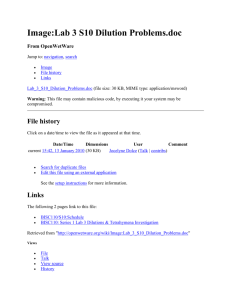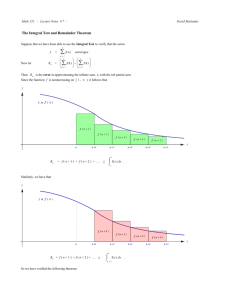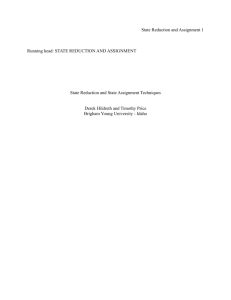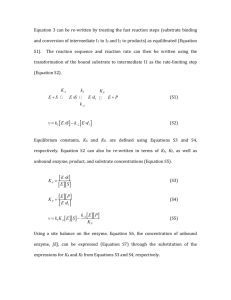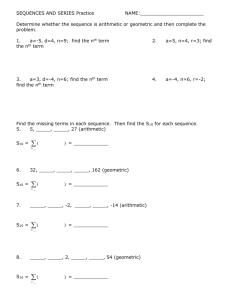Finite State Machine Optimization
advertisement
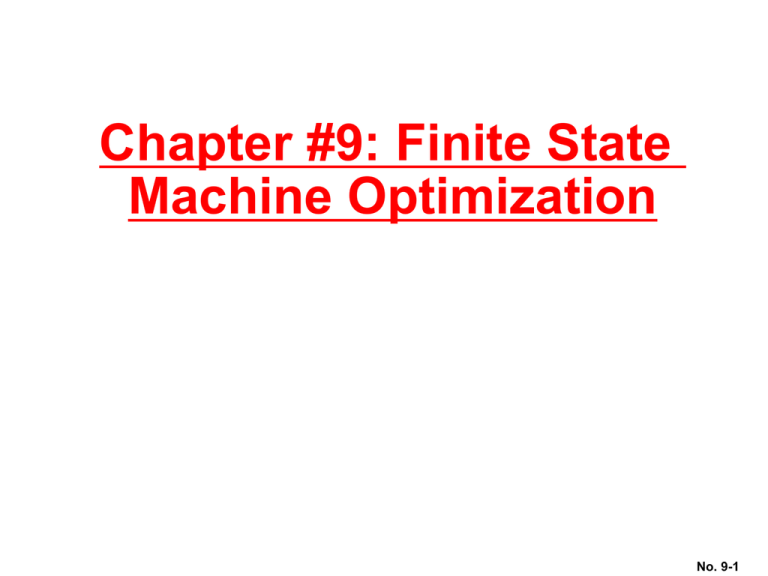
Chapter #9: Finite State Machine Optimization No. 9-1 Chapter Outline Procedures for optimizing implementation of an FSM State Reduction State Assignment Computer Tools for State Assignment: Nova, Mustang, Jedi Choice of Flipflops FSM Partitioning No. 9-2 Motivation Basic FSM Design Procedure: (1) Understand the problem (2) Obtain a formal description (3) Minimize number of states (4) Encode the states This Chapter! (5) Choose FFs to implement state register (6) Implement the FSM Next Chapter No. 9-3 Motivation State Reduction 0 0 S0 [0] S0 [0] 1 1 0 S1 [1] 1 S1 [1] 1 1 S2 [0] 0 0 Odd Parity Checker: two alternative state diagrams Identical output behavior on all input strings FSMs are equivalent, but require different implementations Design state diagram without concern for # of states, Reduce later No. 9-4 Motivation State Reduction (continued) Implement FSM with fewest possible states Least number of flipflops Boundaries are power of two number of states Fewest states usually leads to more opportunities for don't cares Reduce the number of gates needed for implementation No. 9-5 State Reduction Goal Identify and combine states that have equivalent behavior Equivalent States: for all input combinations, states transition to the same or equivalent states Odd Parity Checker: S0, S2 are equivalent states Both output a 0 Both transition to S1 on a 1 and self-loop on a 0 Algorithmic Approach Start with state transition table Identify states with same output behavior If such states transition to the same next state, they are equivalent Combine into a single new renamed state Repeat until no new states are combined No. 9-6 State Reduction Row Matching Method Example FSM Specification: Single input X, output Z Taking inputs grouped four at a time, output 1 if last four inputs were the string 1010 or 0110 Example I/O Behavior: X = 0010 0110 1100 1010 0011 . . . Z = 0000 0001 0000 0001 0000 . . . Upper bound on FSM complexity: Fifteen states (1 + 2 + 4 + 8) Thirty transitions (2 + 4 + 8 + 16) sufficient to recognize any binary string of length four! No. 9-7 State Reduction Row Matching Method State Diagram for Example FSM: Rese t 1/0 0/0 0/0 0/0 1/0 1/0 0/0 1/0 0/0 0/0 0/0 1/0 0/0 0/1 1/0 1/0 0/0 1/0 0/0 1/0 1/0 0/1 1/0 0/0 1/0 0/0 1/0 0/0 1/0 1/0 No. 9-8 State Reduction Row Matching Method Initial State Transition Table: Input Sequenc e Reset 0 1 00 01 10 11 000 001 010 011 100 101 110 111 Next State Output Pres ent State X =0 X =1 X =0 X =1 S0 S1 S2 0 0 S1 S3 S4 0 0 S2 S5 S6 0 0 S3 S7 S8 0 0 S4 S9 S10 0 0 S5 S11 S12 0 0 S6 S13 S14 0 0 S7 S0 S0 0 0 S8 S0 S0 0 0 S9 S0 S0 0 0 S10 S0 S0 1 0 S11 S0 S0 0 0 S12 S0 S0 1 0 S13 S0 S0 0 0 S14 S0 S0 0 0 No. 9-9 State Reduction Row Matching Method Initial State Transition Table: Input Sequenc e Reset 0 1 00 01 10 11 000 001 010 011 100 101 110 111 Next State Output Pres ent State X =0 X =1 X =0 X =1 S0 S1 S2 0 0 S1 S3 S4 0 0 S2 S5 S6 0 0 S3 S7 S8 0 0 S4 S9 S10 0 0 S5 S11 S12 0 0 S6 S13 S14 0 0 S7 S0 S0 0 0 S8 S0 S0 0 0 S9 S0 S0 0 0 S10 S0 S0 1 0 S11 S0 S0 0 0 S12 S0 S0 1 0 S13 S0 S0 0 0 S14 S0 S0 0 0 No. 9-10 State Reduction Row Matching Method Input Sequenc e Reset 0 1 00 01 10 11 000 001 010 011 or 101 100 110 111 Next State Output Pres ent State X =0 X =1 X =0 X=1 S0 0 0 S1 S2 S1 0 0 S3 S4 S2 0 0 S5 S6 S3 0 0 S7 S8 S4 0 0 S9 S'10 S5 0 0 S11 S'10 S6 0 0 S13 S14 S7 0 0 S0 S0 S8 0 0 S0 S0 S9 0 0 S0 S0 S'10 1 0 S0 S0 S11 0 0 S0 S0 S13 0 0 S0 S0 S14 0 0 S0 S0 No. 9-11 State Reduction Row Matching Method Input Sequenc e Reset 0 1 00 01 10 11 000 001 010 011 or 101 100 110 111 Next State Output Pres ent State X =0 X =1 X =0 X=1 S0 0 0 S1 S2 S1 0 0 S3 S4 S2 0 0 S5 S6 S3 0 0 S7 S8 S4 0 0 S9 S'10 S5 0 0 S11 S'10 S6 0 0 S13 S14 S7 0 0 S0 S0 S8 0 0 S0 S0 S9 0 0 S0 S0 S'10 1 0 S0 S0 S11 0 0 S0 S0 S13 0 0 S0 S0 S14 0 0 S0 S0 No. 9-12 State Reduction Row Matching Method Input Sequenc e Reset 0 1 00 01 10 11 not (011 or 101) 011 or 101 Next State Output Pres ent State X =0 X =1 X =0 X=1 0 0 S2 S1 S0 0 0 S4 S3 S1 0 0 S6 S5 S2 0 0 S'7 S7' S3 0 0 S'10 S7' S4 0 0 S'10 S7' S5 0 0 S'7 S7' S6 0 0 S0 S0 S'7 0 1 S0 S0 S'10 No. 9-13 State Reduction Row Matching Method Input Sequenc e Reset 0 1 00 01 10 11 not (011 or 101) 011 or 101 Next State Output Pres ent State X =0 X =1 X =0 X=1 0 0 S2 S1 S0 0 0 S4 S3 S1 0 0 S6 S5 S2 0 0 S'7 S7' S3 0 0 S'10 S7' S4 0 0 S'10 S7' S5 0 0 S'7 S7' S6 0 0 S0 S0 S'7 0 1 S0 S0 S'10 No. 9-14 State Reduction Row Matching Method Final Reduced State Transition Table Nex t State X=0 X=1 S1 S2 S3' S4' S4' S3' S7' S7' S7' S10 ' S0 S0 S0 S0 Input Se quence Prese nt State Res et S0 0 S1 1 S2 00 or 11 S3' 01 or 10 S4' not (011 or 10 1) S7' 01 1 or 1 01 S10 ' Output X=0 X=1 0 0 0 0 0 0 0 0 0 0 0 0 1 0 Res et S0 0/0 S1 Corresponding State Diagram S2 1/0 0/0 1/0 0/0 1/0 S7' 0,1/0 0/0 S4' S3' 0,1/0 1/0 S10 ' 0/1 1/0 No. 9-15 State Reduction Row Matching Method Straightforward to understand and easy to implement Problem: does not allows yield the most reduced state table! Example: 3 State Odd Parity Checker Present State S0 S1 S2 Next X =0 S0 S1 S2 State X =1 S1 S2 S1 Output 0 1 0 No way to combine states S0 and S2 based on Next State Criterion! No. 9-16 State Reduction Implication Chart Method New example FSM: Single input X, Single output Z Output a 1 whenever the serial sequence 010 or 110 has been observed at the inputs State transition table: Input Sequenc e Reset 0 1 00 01 10 11 Next State Pres ent State X=0 X =1 S0 S1 S2 S1 S3 S4 S2 S5 S6 S3 S0 S0 S4 S0 S0 S5 S0 S0 S6 S0 S0 Output X =0 X=1 0 0 0 0 0 0 0 0 1 0 0 0 1 0 No. 9-17 State Reduction Implication Chart Method Enumerate all possible combinations of states taken two at a time S0 Next States Under all Input Combinations S1 S1 S2 S2 S3 S3 S4 S4 S5 S5 S6 S6 S0 S1 S2 S3 S4 S5 S6 Naive Data Structure: Xij will be the same as Xji Also, can eliminate the diagonal S0 S1 S2 S3 S4 S5 Implication Chart No. 9-18 State Reduction Implication Chart Filling in the Implication Chart Entry Xij ?Row is Si, Column is Sj Si is equivalent to Sj if outputs are the same and next states are equivalent Xij contains the next states of Si, Sj which must be equivalent if Si and Sj are equivalent If Si, Sj have different output behavior, then Xij is crossed out Example: S0 transitions to S1 on 0, S2 on 1; S1 transitions to S3 on 0, S4 on 1; So square X<0,1> contains entries S1-S3 (transition on zero) S2-S4 (transition on one) S0 S1-S3 S2-S4 S1 No. 9-19 State Reduction Implication Chart Method S2 and S4 have different I/O behavior S1 S1-S3 S2-S4 S2 S1-S5 S3-S5 S2-S6 S4-S6 S3 S1-S0 S3-S0 S5-S0 S2-S0 S4-S0 S6-S0 This implies that S1 and S0 cannot be combined S4 S5 S1-S0 S3-S0 S5-S0 S0-S0 S2-S0 S4-S0 S6-S0 S0-S0 S0-S0 S0-S0 S6 S0 S1 S2 S3 S4 S5 Starting Implication Chart No. 9-20 State Reduction Implication Chart Method S1 Results of First Marking Pass S3-S5 S4-S6 S2 Second Pass Adds No New Information S3 and S5 are equivalent S4 and S6 are equivalent This implies that S1 and S2 are too! S3 S4 S0-S0 S0-S0 S5 S0-S0 S0-S0 S6 S0 Input Sequenc e Reset Reduced State 0 or 1 Transition Table 00 or 10 01 or 11 S1 S2 S3 Next State Pres ent State X =0 X =1 S0 S1' S'1 S1' S3' S'4 S3' S0 S0 S4' S0 S0 S4 S5 Output X =0 X =1 0 0 0 0 0 0 1 0 No. 9-21 State Reduction Multiple Input State Diagram Example 10 00 00 S0 [1] S1 [0] 01 11 10 01 00 S2 [1] 01 01 00 S3 [0] 10 10 01 10 S4 [1] Pres ent State S0 S1 S2 S3 S4 S5 00 S0 S0 S1 S1 S0 S1 Next 01 S1 S3 S3 S0 S1 S4 State 10 S2 S1 S2 S4 S2 S0 Output 11 S3 S5 S4 S5 S5 S5 1 0 1 0 1 0 11 11 00 11 00 10 11 01 Symbolic State Diagram S5 [0] 11 State Diagram No. 9-22 State Reduction Multiple Input Example S1 S2 S0-S1 S1-S3 S2-S2 S3-S4 S3 S4 Pres ent State S'0 S1 S2 S'3 S0-S1 S3-S0 S1-S4 S5-S5 S0-S0 S1-S1 S2-S2 S3-S5 S5 Output 11 S3' S3' S0' S'3 1 0 1 0 Minimized State Table S1-S0 S3-S1 S2-S2 S4-S5 S0-S1 S3-S4 S1-S0 S5-S5 S0 Next State 00 01 10 S0' S1 S2 S0' S3' S1 S1 S3' S2 S1 S'0 S'0 S1 S1-S1 S0-S4 S4-S0 S5-S5 S2 S3 S4 Implication Chart No. 9-23 State Reduction Implication Chart Method Does the method solve the problem with the odd parity checker? S1 Implication Chart S2 S0 -S2 S1 -S1 S0 S1 S0 is equivalent to S2 since nothing contradicts this assertion! No. 9-24 State Reduction Implication Chart Method The detailed algorithm: 1. Construct implication chart, one square combination of states taken two at a time for each 2. Square labeled Xi,j, if outputs differ than square gets "X". Otherwise write down implied state pairs for all input combinations 3. Advance through chart top-to-bottom and left-to-right. If square Xi,j contains next state pair Sm, Sn and that pair labels a square already labeled "X", then Xi,j is labeled "X". 4. Continue executing Step 3 until no new squares are marked with "X". 5. For each remaining unmarked square Xi,j, then Si and Sj are equivalent. No. 9-25 State Assignment When FSM implemented with gate logic, number of gates will depend on mapping between symbolic state names and binary encodings 4 states = 4 choices for first state, 3 for second, 2 for third, 1 for last = 24 different encodings (4!) Example for State Assignment: Traffic Light Controller HG 00 00 00 00 00 00 01 01 01 01 01 01 HY 01 01 10 10 11 11 00 00 10 10 11 11 FG 10 11 01 11 01 10 10 11 00 11 00 10 FY 11 10 11 01 10 01 11 10 11 00 10 00 HG 10 10 10 10 10 10 11 11 11 11 11 11 HY 00 00 01 01 11 11 00 00 01 01 10 10 FG 01 11 00 11 00 01 01 10 00 10 00 01 24 state assignments for the traffic light controller FY 11 01 11 00 01 00 10 01 10 00 01 00 Inputs C TL TS 0 X X X 0 X 1 1 X X X 0 X X 1 1 0 X 0 X X X 1 X X X 0 X X 1 Present State Q1 Q0 HG HG HG HY HY FG FG FG FY FY Next State P1 P0 HG HG HY HY FG FG FY FY FY HG ST 0 0 1 0 1 0 1 1 0 1 Outputs H 1 H 0 F1 F0 00 10 00 10 00 10 01 10 01 10 10 00 10 00 10 00 10 01 10 01 Symbolic State Names: HG, HY, FG, FY Green=00, Yellow=01, Red=10 No. 9-26 State Assignment Some Sample Assignments for the Traffic Light Controller Espresso input format: .i 5 .o 7 .ilb c tl ts q1 q0 .ob p1 p0 st h1 h0 f1 f0 .p 10 0-- HG HG 00010 -0- HG HG 00010 11- HG HY 10010 --0 HY HY 00110 --1 HY FG 10110 10- FG FG 01000 0-- FG FY 11000 -1- FG FY 11000 --0 HY FY 01001 --1 HY HG 11001 .e Two assignments: HG = 00, HY = 01, FG = 11, FY = 10 HG = 00, HY = 10, FG = 01, FY = 11 No. 9-27 State Assignment Random Assignments Evaluated with Espresso .i 5 .o 7 .ilb c tl ts q1 q0 .ob p1 p0 st h1 h0 f1 f0 .p 9 11-00 0110000 10-11 1101000 --101 1010000 --010 1001001 ---01 0100100 --110 0011001 ---0- 0000010 0--11 1011000 -1-11 1011000 .e 26 literals 9 unique terms several 5 and 4 input gates 13 gates total .i 5 .o 7 .ilb c tl ts q1 q0 .ob p1 p0 st h1 h0 f1 f0 .p 8 11-0- 1010000 --010 1000100 0--01 1010000 --110 0110100 --111 0011001 ----0 0000010 ---01 0101000 --011 1101001 .e 21 literals 8 unique terms no 5 input gates, 2 4 input gates 14 gates total No. 9-28 State Assignment Pencil & Paper Heuristic Methods State Maps: similar in concept to K-maps If state X transitions to state Y, then assign "close" assignments to X and Y S0 0 S1 1 S2 Ass ignment State Name Q2 Q 1 Q0 S0 0 0 0 S1 1 0 1 S2 1 1 1 S3 0 1 0 S4 0 1 1 Ass ignment S3 S4 As signment State Name Q2 Q1 Q0 S0 0 0 0 S1 0 0 1 S2 0 1 0 S3 0 1 1 S4 1 1 1 Q1 Q 0 Q2 00 01 0 S0 1 S1 As signment 11 10 S4 S3 S2 State Map Q1 Q 0 Q2 00 01 11 10 0 S0 S1 S3 S2 1 S4 State Map No. 9-29 State Assignment Paper and Pencil Methods Minimum Transition Distance Criterion Transition S0 to S1: S0 to S2: S1 to S3: S2 to S3: S3 to S4: S4 to S1: First Assignment Second Assignment Bit Changes Bit Changes 2 1 3 1 3 1 2 1 1 1 2 2 13 7 This heuristic is not likely to achieve the best assignment! E.g., traffic light controller: HG = 00, HY = 01, FG = 11, FY = 10 yields minimum transition distance, but turned out not best assignment as shown in 9-28! No. 9-30 State Assignment Paper & Pencil Methods Alternative heuristics based on input and output behavior as well as transitions: i/j Adjacent assignments to: i/k states that share a common next state for a given input (group 1's in next state map) Highest Priority states that share a common ancestor state (group 1's in next state map) Medium Priority i/j i/j states that have common output behavior (group 1's in output map) Lowest Priority No. 9-31 State Assignment Pencil and Paper Methods Example: 3-bit Sequence Detector Rese t S0 Highest Priority: (S3', S4') 0,1 /0 Medium Priority: (S3', S4') Lowest Priority: 0/1 , 0/0: (S0, S1', S3') 1/0: (S0, S1', S3', S4') 1/0 S1' 0,1 /0 1/0 S3' 0/0 S4' No. 9-32 State Assignment Paper and Pencil Methods Q0 Q1 0 1 S0 S1' 1 S3' S4' 0 Reset State = 00 Q0 Q1 Highest Priority Adjacency 0 1 S0 S3' 1 S1' S4' 0 Not much difference in these two assignments No. 9-33 State Assignment Paper & Pencil Methods Another Example: 4 bit String Recognizer S0 0/0 S1 1/0 0/0 1/0 0/0 S2 Medium Priority: (S1, S2), 2x(S3', S4'), (S7', S10') 1/0 0/0 Lowest Priority: 0/0: (S0, S1, S2, S3', S4', S7') 1/0: (S0, S1, S2, S3', S4', S7') 1/0 S7' 0,1/0 Highest Priority: (S3', S4'), (S7', S10') S4' S3' 0,1/0 Res et S10 ' 0/1 1/0 No. 9-34 State Assignment Paper & Pencil Methods State Map Q1 Q0 00 Q2 0 01 11 10 S0 0 1 01 11 S0 1 Q1 Q0 00 Q2 0 00 = Reset = S0 01 11 10 01 11 10 S0 01 S0 1 10 Q1 Q0 00 Q2 S3' 0 S0 S4' 1 S7' Q1 Q0 Q2 00 S10' 11 10 S3' S7' 0 S0 S3' S4' S10' 1 S7' S4' S10' 01 11 10 11 01 11 10 S0 S1 S3' S7' 0 S0 S1 S3' S2 S4' S10' 1 S7' S2 S4' 1 (a) Q1 Q0 Q2 00 01 Q1 Q0 00 Q2 0 (S1, S2), (S3', S4'), (S7', S10') placed adjacently 1 Q1 Q0 00 Q2 0 Q1 Q0 00 Q2 10 S10' (b ) No. 9-35 State Assignment Effect of Adjacencies on Next State Map (Q1,Q2,Q3 P1,P2,P3) (a) in the previous slide Current State (S0 ) 000 (S1 ) 001 (S2 ) 101 ( S'3 ) 011 (S4' ) 111 ( S7' ) 010 (S'10) 110 Next State X = 0 X= 1 001 101 011 111 111 011 010 010 010 110 000 000 000 000 Q2 Q1 00 Q0 X 00 0 01 0 11 0 10 X Q2 Q 1 00 Q0 X 00 0 01 1 0 0 X 01 11 1 0 1 0 10 0 0 0 1 11 0 10 X 0 0 0 X 01 11 1 1 1 1 10 1 1 1 1 P2 Current State ( S0) 000 ( S1) 001 ( S2) 010 ( S3' ) 011 ( S'4 ) 100 ( S7' ) 101 (S'10) 110 Next State X = 0 X= 1 001 010 011 100 100 011 101 101 101 110 000 000 000 000 01 0 11 0 10 X 1 0 0 X 11 1 0 0 1 10 1 0 0 1 01 11 10 0 0 1 P1 Q2 Q1 00 Q0 X 00 0 01 11 10 1 0 1 01 0 0 0 1 01 11 1 1 X 0 10 0 1 X 0 P2 Q2 Q1 00 Q0 X 00 1 01 0 Q2 Q1 00 Q0 X 00 0 P0 Q2 Q1 00 Q0 X 00 1 01 11 10 0 0 0 1 1 0 1 01 0 1 0 0 11 0 0 X 0 11 0 1 X 0 10 1 0 X 0 10 1 1 X 0 P1 P0 First encoding exhibits a better clustering of 1's in the next state map No. 9-36 State Assignment One Hot Encodings to reduce next-state and output logic complexity n states encoded in n flipflops HG = 0001 HY = 0010 FG = 0100 FY = 1000 .i 7 .o 9 .ilb c tl ts q3 q2 q1 q0 .ob p3 p2 p1 p0 st h1 h0 f1 f0 .p 10 0-- 0001 0001 00010 -0- 0001 0001 00010 11- 0001 0010 10010 --0 0010 0010 00110 --1 0010 0100 10110 10- 0100 0100 01000 0-- 0100 1000 11000 -1- 0100 1000 11000 --0 0010 1000 01001 --1 0010 0001 11001 .e Espresso Inputs Complex logic for discrete gate implementation .i 7 .o 9 .ilb c tl ts q3 q2 q1 q0 .ob p3 p2 p1 p0 st h1 h0 f1 f0 .p 8 10-0100 010001000 11-0001 001010010 -0-0001 000100010 0--0001 000100010 0--0100 100011000 -1-0100 100011000 --00010 101001111 --10010 010111111 .e Espresso Outputs No. 9-37 State Assignment One Hot Encoding Results: • Yields eight product terms cf. P.9-28 • But, all the terms are too complicated with many literals • Could be OK if PLAbased design used No. 9-38 Choice of Flipflops J-K FFs: reduce gate count, increase # of connections D FFs: simplify implementation process, decrease # of connections, good for VLSI implementations Procedure: 1. Given state assignments, derive the next state maps from the state transition table 2. Remap the next state maps given excitation tables for a given FF 3. Minimize the remapped next state function No. 9-50 Choice of Flipflops Examples 4 bit Sequence Detector using NOVA derived state assignment Encoded State Transition Table Encoded Next State Map Present State 000 (S0) 011 ( S1) 010 (S2) 101 (S'3) 111 (S'4 ) 100 (S7') 110 ( S10' ) Next State I =0 I =1 011 (S1 ) 010 ( S2 ) 101 (S3' ) 111 (S'4) 111 ( S'4) 101 (S'3 ) 100 100 (S'7 ) ( S'7) 110 100 ( S10' ) ( S'7) 000 Pres ent State 000 001 010 011 100 101 110 111 Output I =0 I =1 0 0 0 0 0 0 0 0 0 0 0 0 1 0 Next State I =0 I =1 011 010 XXX XXX 111 101 101 111 000 000 100 100 000 000 100 110 No. 9-51 Choice of Flipflops D FF Implementation D D Q2+ Q1+ = Q2•Q1 + Q0 Q0 I 00 01 11 10 00 0 0 X X 01 1 1 1 1 11 0 0 1 1 10 0 0 1 1 Q2 Q1 Q 2+ = Q1 • Q0 • I + Q2 • Q0 • I + Q2 • Q1 Q0 I 00 01 11 10 00 1 1 X X 01 1 0 1 0 11 0 0 1 0 10 0 0 0 0 01 11 10 Q2 Q1 D Q0+ = Q2 • Q1 + Q2 • I Q1+ 6 product terms 15 literals Q2 Q1 Q0 I 00 00 1 0 X X 01 1 1 1 1 11 0 0 0 0 10 0 0 0 0 Q0+ No. 9-52 Choice of Flipflops J-K Implementation Remapped Nex t State Next State Present State 000 001 010 01 1 100 101 110 111 I =0 I =1 011 010 XXX XXX 111 101 101 111 000 000 100 100 000 000 100 110 J I =0 011 XXX 1X1 1XX X00 X0X XX0 XXX K I =0 XXX XXX X0X X10 1XX 0X1 11X 011 J I=1 010 XXX 1X1 1XX X00 X0X XX0 XXX K I =1 XXX XXX X1X X00 1XX 0X1 11X 001 Remapped Next State Table No. 9-53 Choice of Flipflops J-K Implementation (continued) Q0 I J Q2+ = Q1 Q0 I 00 01 11 10 00 0 0 X X 01 1 1 1 1 11 X X X 10 X X X Q 2 Q1 K Q2+ = Q0 00 01 11 10 X X X X 01 X X X X X 11 1 1 0 0 X 10 1 1 0 0 Q2 Q 1 00 KQ + JQ 2+ 2 Q0 I J Q1+ = Q2 K Q1+ = Q0 • I + Q0 • I + Q2 • Q0 Q0 I 00 01 11 10 00 1 1 X X 01 X X X Q2 Q 1 11 X 10 0 X 0 00 01 11 10 00 X X X X X 01 0 1 0 1 X X 11 1 1 0 1 0 0 10 X X X X 01 11 10 Q2 Q1 JQ + KQ + 1 J Q0+ = Q2 • Q1 + Q2 • I K Q0+ = Q2 9 unique terms 14 literals 1 Q0 I Q2 Q1 Q0 I 00 00 01 11 10 00 1 0 X X 00 X X X X 01 1 1 X X 01 X X 0 0 11 0 0 X X 11 X X 1 1 10 0 0 X X 10 X X 1 1 JQ 0+ Q2 Q1 KQ 0+ No. 9-54 Finite State Machine Partitioning Why Partition? mapping FSMs onto programmable logic components: limited number of input/output pins limited number of product terms or other programmable resources 15 5 Firs t Partition 20 inputs Next-State and Output Functions 10 outputs 20 10 15 S t a t e Second Partition 5 S t a t e Example of Input/Output Partitioning: 5 outputs depend on 15 inputs 5 outputs depend on different overlapping set of 15 inputs No. 9-55 Finite State Machine Partitioning Introduction of Idle States in the hope of reducing # of terms In the next-state functions Before Partitioning C1 S1 S6 C2 C3 S2 S3 C4 S5 C5 S4 No. 9-56 Finite State Machine Partitioning Introduction of Idle States After Partitioning C2•S6 C1 S1 C2•S6 S6 SA C1•S1 C2 C3+C5 SB S2 C3•S2 + C4•S3 C1•S1 + C3•S2 + C4•S3 + C5•S2 C4 S5 C5•S2 S4 S3 No. 9-57 Finite State Machine Partitioning Rules for Partitioning Rule #1: Source State Transformation; SA is the Idle State S1 C1 C1 S6 S1 SA Rule #2: Destination State Transformation S1 C2 S6 S1 C2•S6 SA No. 9-58 Finite State Machine Partitioning Rules for Partitioning Rule #3: Multiple Transitions with Same Source or Destination C3 S2 S2 S5 C3+C5 SA S3 C4 C5 S4 S3 C4 C3•S2 + C4•S3 S5 C5•S2 S4 SB Rule #4: Hold Condition for Idle State C2•S6 S1 C2•S6 SA No. 9-59 Finite State Machine Partitioning Another Example D S0 S5 U D D U U S1 S4 U U D D U S2 S3 D 6 state up/down counter building block has 2 FFs + combinational logic No. 9-60 Finite State Machine Partitioning 6 State Up/Down Counter S0 S5 D D U U U • S5 S1 SA U U D D D • S0 U•S5 + D•S3 D • S3 U SB S4 U • S2 U D • S0 + U • S2 D D S2 S3 Introduction of the two idle state SA, SB Count sequence S0, S1, S2, S3, S4, S5: S2 goes to SA and holds, leaves after S5 S5 goes to SB and holds, leaves after S2 Down sequence is similar No. 9-61 Chapter Summary Optimization of FSM State Reduction Methods: Row Matching, Implication Chart State Assignment Methods: Heuristics and Computer Tools Implementation Issues Choice of Flipflops Finite State Machine Partitioning No. 9-62

